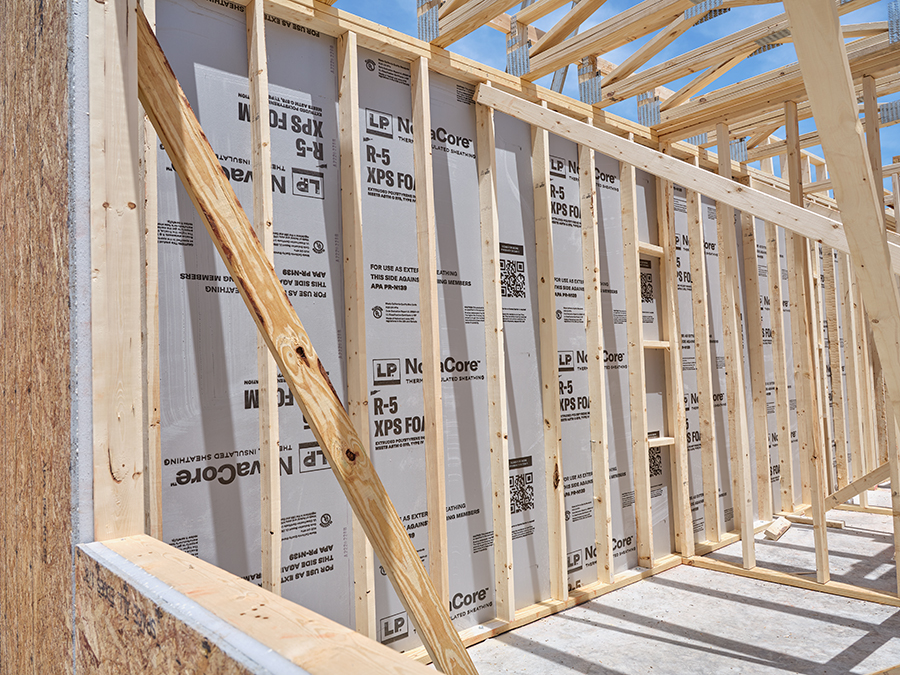Inspiration6 min
House Renovations: Adding Continuous Insulative Sheathing To Home Additions
Home additions not only provide extra living space, but they also give homeowners the chance to tackle issues they're unhappy about in their existing homes. One topic that frequently arises is an energy-inefficient home with drafty rooms or high heating and cooling costs. In the past ten years, builders are focusing on adding additional insulation to your home-including new continuous insulative sheathing products. Let's take a look at how continuous insulation is adding comfort and value to home additions.
What is Continuous Insulation?
Continuous insulation refers to the insulating materials that are installed continuously across all structural members without thermal bridges other than fasteners and service openings. It gets its name because you should be able to trace a continuous line around the entire dwelling where the insulating materials are installed within a home.
There are three main types of continuous insulation-rigid foam, mineral wool and cork. While traditional batting and other forms of insulation are good for insulating homes, they allow thermal bridging.
Thermal bridging happens when heat finds a path in or out of a building due to an interruption in insulation. Studs and other framing members are typical paths where thermal bridging occurs.
Ways of Adding Continuous Insulation Sheathing for Home Additions
While your customers likely complain about drafty bonus rooms or high heating and cooling bills, installing continuous insulation products like LP NovaCore® Thermal Insulated Sheathing is an important step to providing your homeowner a comfortable new addition.

LP NovaCore sheathing helps protect structures against heat loss and gain and delivers an R-value of 5 per inch of foam thickness. The dual-layered sheathing panels consist of structural OSB and XPS foam bonded together to create an insulated wall panel. It's easy to install and can be handled, cut and drilled like OSB.
How Continuous Insulation Provides Cost-Effective Solutions
Many traditional homes were built with 2x4 studs with R-13 batting insulation in between, which offered good insulation at the time.
"Now we're seeing energy codes requiring a wall to be R-20; R-13 won't cut it any longer," says Chris Dall, Product Manager, Growth & Innovation at LP Building Solutions. "This means builders have to go with 2x6 studs with thicker insulation. While these thicker walls meet the R-20 requirements the issue of thermal bridging remains, and the heat inside the house is going through the drywall and radiating through the sheathing."
Dall explains this is where continuous insulation sheathing plays a critical role. "LP NovaCore sheathing offers R-5 insulation performance. Builders can use 2x4 studs with R-13 insulation and add LP NovaCore sheathing to meet R13+5 (the alternative requirement to R20 cavity-only insulation)."
Builders can decrease thermal bridging and increase the overall energy efficiency of the addition by adding continuous insulation to the exterior walls, offering a much more comfortable addition for their homeowner clients.
Discussion Points for Adding Additional Insulation to Your Home
Most of Dall's job is spent in the field, talking to builders like you about problems that need a solution. He discovered builders were having difficulties meeting stricter energy codes and needed an option for a structural panel related to foam.
That's why he's particularly excited about LP NovaCore continuous insulated sheathing. "One benefit to this product is that it's relevant at both ends of the spectrum. This is a two-for-one product: it offers both structural capacity and the comfort of continuous insulation," says Dall.

Dall noted customers may not be interested in codes, but they certainly are concerned about their monthly heating and cooling bills. "Talk to your customers about the essential benefits of LP NovaCore Thermal Insulated Sheathing. It's all about occupant comfort. With a greater level of insulation, their new addition is going to be that much more comfortable," says Dall. "It's like putting a warm coat around the new addition."
Learn more about R-values and building insulation methods from a conversation with LP Building Science Manager Neil Freidberg.
Continue Reading
Resiliency Solutions
5 minIntroducing LP® SmartSide® ExpertFinish® Naturals Collection™: Nature-Inspired Beauty Meets Engineered Performance
We’re excited to introduce the LP® SmartSide® ExpertFinish® Naturals Collection™, a bold new addition to our trusted line of engineered wood siding and trim that delivers the warmth and beauty of nature with the advanced protection and performance builders and homeowners expect.
Labor Solutions
5 minChoosing the Right LP® Structural Solutions Product for Your Build
When it comes to building strong, reliable, and high-performing structures, the materials you choose matter. At LP Building Solutions, we understand that every project, whether it's a single-family home or a multifamily development, requires structural components that meet your needs for strength, durability, and efficiency.
Sustainability Solutions
5 minBuilding a More Sustainable Future with LP Building Solutions
In today's world, sustainability is no longer just a buzzword, it's a blueprint for responsible living and smarter building. As the construction industry seeks ways to reduce its environmental footprint, LP Building Solutions is focused on providing innovative building materials for eco-conscious builders to help reshape what it means to build sustainably
News & Stories3 min
History of Partnership with Gary Sinise Foundation
The LP Foundation is a proud partner of the Gary Sinise Foundation, which supports wounded veterans in several ways. You can learn more about the LP Foundation here.